- Home
- Introduction
- 1. Design rights
- 1.1. Design rights: overview
- 1.2. What a design right protects
- 1.3. Why protect a design?
- 1.4. How designs are protected in Australia?
- 2. Application for registration
- 2.1. Application for registration: overview
- 2.2. Registration process
- 2.3. Submitting an application
- 2.4. Minimum filing requirements
- 2.5. Who is entitled to be a registered owner?
- 2.6. Types of applications (s 22)
- 2.7. Request for registration
- 2.8. Further designs
- 3. Fees
- 3.1. Fees: overview
- 3.2. Application fees
- 3.3. Renewal fees
- 3.4. Examination fees
- 3.5. Hearing fees
- 3.6. Fees for extensions of time
- 3.7. Refunds
- Production test Designs
- 4. Formalities assessment
- 4.1. Formalities assessment: overview
- 4.2. The ‘Formalities check’ and ‘Formal requirements’
- 4.3. Formalities notices
- 5. Applicant details
- 5.1. Applicant name: overview
- 5.1.1. Is the applicant a person?
- 5.1.2. Individual (Australian and overseas, including joint owners)
- 5.1.3. Australian company (Pty Ltd, Ltd)
- 5.1.4. Strata company, owners corporation, body corporate etc
- 5.1.5. Government entity
- 5.1.6. Incorporated association
- 5.1.7. Overseas entity (AG, S.r.L etc)
- 5.1.8. Several applicant names, multiple designs
- 5.1.9. Joint owner names with ABN
- 5.1.10. Partnership
- 5.1.11. Trust/trustee
- 5.1.12. Business names and 'trading as'
- 5.1.13. Applicant name and design owner
- 5.2. Applicant address
- 6. Representations
- 6.1. Representations: overview
- 6.2. General requirements
- 6.3. Formal compliance
- 6.4. Product
- 6.5. Consistency
- 6.6. Text
- 6.7. Common designs
- 6.8. Drawings
- 6.9. Photographs
- 6.10. Specimens or 3D models
- 6.11. Different views
- 6.12. Environmental views
- 6.13 Pairs and mirror images
- 7. Classification
- 7.1. Classification: overview
- 7.2. Classification systems
- 7.3. Finding the right class
- 7.4. Cases of doubt
- 7.5. More than one possible classification
- 7.6. Multiple products or designs
- 8. Examination and certification
- 8.1. Examination and certification: overview
- 8.2. Examination and certification processes
- 8.3. Requesting examination
- 8.4. Third party initiated examinations
- 8.5. Concurrent requests for examination
- 8.6. Expedited examination
- 8.7. Material provided by a third party
- 8.8. Relevant material that must be considered
- 8.9. Time frame for completion of examination and last-minute responses
- 8.10. Withdrawal of request for examination
- 8.11. Notice of intention to certify
- 8.12. Requests for examination after certification
- 8.13. Further examination reports
- 8.14. Revocation
- 8.15. Examination hearings
- 8.16. Examination on Registrar's initiative
- 9. Identifying the design
- 9.1. Identifying the design: overview
- 9.2. Overall appearance
- 9.3. Visual features
- 9.4. Variable visual features
- 9.5. What cannot be a visual feature
- 10. Product
- 10.1. Product: overview
- 10.2. Identifying the product
- 10.3. Things that are not products
- 10.4. Things that are not different products
- 10.5. Product name
- 10.6. Manufactured or handmade
- 10.7. Component part of a complex product
- 10.8. Assembled set or kit
- 10.9. Indefinite dimensions
- 10.10. Examples - things that are / are not products
- 11. Excluded designs
- 11.1. Excluded designs: overview
- 11.2. Priority date of excluded designs
- 11.3. Extensions of time
- 11.4. Amendments
- 11.5. Registration/publication requests
- 12. Section 43 refusal to register
- 12.1. Section 43 refusal to register: overview
- 12.2. Medals
- 12.3. Anzac
- 12.4. Currency
- 12.5. Scandalous content
- 12.6. Arms, flags, emblems etc.
- 12.7. Olympic symbols
- 12.8. Integrated circuits
- 13. Assessing newness and distinctiveness
- 13.1. Assessing newness and distinctiveness: overview
- 13.2. Product name and intended use
- 13.3. Identifying the product
- 13.4. Test for newness
- 13.5. Test for distinctiveness
- 13.6. Substantially similar in overall impression
- 13.7. How the design is displayed
- 13.8. Other visual features
- 13.9. Searching
- 14. Section 19 requirements for distinctiveness
- 14.1. Section 19 requirements for distinctiveness: overview
- 14.2. Similarities and differences
- 14.3. State of development of the prior art base
- 14.4. Statement of newness and distinctiveness
- 14.5. Amount, quality and importance
- 14.6. Freedom of the creator of the design to innovate
- 14.7. Familiar person / Informed user
- 15. Statement of newness and distinctiveness
- 15.1. Statement of newness and distinctiveness: overview
- 15.2. Formalities assessment of the SoND
- 15.3. Amendments to the SoND
- 15.4. Using the SoND to assess distinctiveness
- 16. Standard of the familiar person / informed user
- 16.1. Standard of the familiar person / informed user: overview
- 16.2. Identifying the familiar person / informed user
- 16.3. Declarations about the familiar person / informed user
- 16.4. Familiarity with the product
- 16.5. References to European and UK decisions
- 16.6. Familiar person’s / informed user’s knowledge base versus prior art base
- 17. Prior art base
- 17.1. Prior art base: overview
- 17.2 Publicly used in Australia
- 17.3. Published in a document within or outside of Australia
- 17.4. Trade marks and patents as citations
- 17.5. Establishing the publication date
- 17.6. Designs disclosed in applications
- 18. Prior publication or use exceptions
- 18.1. Prior publication or use exceptions: overview
- 18.2. Exhibitions
- 18.3. Unauthorised disclosures
- 18.4. Disclosure to government
- 18.5. Copyright
- 18.6. Grace Period
- Annex A - An example of a grace period declaration
- 19. Priority date
- 19.1. Priority date: overview
- 19.2. Convention application
- 19.3. Multiple bases for priority
- 19.4. Plural designs
- 19.5. When priority must be asserted
- 19.6. Excluded designs
- 19.7. Converted applications
- 19.8. Applications by an entitled person
- 20. Convention priority
- 20.1. Convention priority: overview
- 20.2. Convention countries
- 20.3. Time limit to claim convention priority
- 20.4. Assessing convention priority claims
- 20.5. Convention priority for excluded designs and applications that include more than one design
- 20.6. Basic application
- 20.7. Requesting the basic application
- 20.8. Relevance of the basic application to examination
- 21. Satisfied
- 21.1. Satisfied: overview
- 21.2. Meaning of ‘satisfied’
- 21.3. ‘Satisfied’ as to prior art base
- 21.4. Reasonable doubt, balance of probabilities and uncertainty
- 21.5. ‘Not satisfied’
- 22. Amendments
- 22.1. Amendments: overview
- 22.2. Amending an application
- 22.3. Amending a registration
- 22.4. Inclusion of matter not in substance disclosed
- 22.5. Increasing the scope of the design registration
- 22.6. Other types of amendments
- 23. Extensions of time
- 23.1. Extensions of time: overview
- 23.2. Legal principles
- 23.3. Error or omission by the Registrar
- 23.4. Error or omission by the customer
- 23.5. Circumstances beyond the customer’s control
- 23.6. Registrar’s discretion
- 23.7. Protection for third parties
- 23.8. Period of extension
- 23.9. Extensions process
- 23.10. Advertisement
- 23.11. Request from an unrecorded new owner
- 23.12. Extension of the convention priority period
- 24. Assignments (and other interests)
- 24.1. Assignments and other interests: overview
- 24.2. Recording changes of ownership
- 24.3. Possible complications
- 24.4. Bankruptcy and winding up
- 24.5. Registering other interests
- 25. Ownership disputes
- 25.1. Ownership disputes: overview
- 25.2. Disputes between joint applicants
- 25.3. Disputes where a non-applicant claims ownership
- 25.4. Disputes where some designs have been registered or published
- 25.5. Disputes about recording a change of ownership before registration
- 25.6. Typical situations where ownership disputes arise
- 25.7. Revocation after an ownership dispute
- 26. Production of documents under s 61(1)
- 26.1. Production of documents under s 61(1): overview
- 26.2. Powers of the courts
- 26.3. Powers of the Registrar
- 26.4. Precedent
- 26.5. Who access is granted to
- 26.6. Access in ownership disputes
- 26.7. Where inspection can take place
- 26.8. Right of lien
- 26.9. Draft undertaking for access
- 27. Publication and file access
- 27.1. Publication and file access: overview
- 27.2. Designs not publicly available
- 27.3. Legal exceptions
- 27.4. Freedom of information
- 27.5. Prohibition orders
- 28. Hearings
- 28.1. Hearings: overview
- 28.2. Filing evidence
- 28.3. Disputes over whether the design was new and distinctive at the priority date
- 28.4. Interface with court proceedings
- 29. Glossary
- 30. Citation index
- 31. Keyword index
- 32. Classification listings
- Class Heading Summary
- Class 01 Foodstuffs
- Class 02 Articles of clothing and haberdashery
- Class 03 Travel goods, cases, parasols and personal belongings not elsewhere specified
- Class 04 Brushware
- Class 05 Textile piecegoods, artificial and natural sheet material
- Class 06 Furnishing
- Class 07 Household goods not elsewhere specified
- Class 08 Tools and hardware
- Class 09 Packages and containers for the transport or handling of goods
- Class 10 Clocks and watches and other measuring instruments, checking and signalling instruments
- Class 11 Articles of adornment
- Class 12 Means of transport or hoisting
- Class 13 Equipment for production, distribution or transformation of energy
- Class 14 Recording, communication or information retrieval equipment
- Class 15 Machines not elsewhere specified
- Class 16 Photographic, cameras, cinematographic and optical apparatus
- Class 17 Musical instruments
- Class 18 Printing and office machinery
- Class 19 Stationery and office equipment, artists and teaching materials
- Class 20 Sales and advertising equipment, signs
- Class 21 Games, toys, tents and sporting goods
- Class 22 Arms, pyrotechnic articles, articles for hunting, fishing and pest killing
- Class 23 Fluid distribution equipment, sanitary, heating, ventilation and air conditioning equipment, solid fuel
- Class 24 Medical and laboratory equipment
- Class 25 Building units and construction elements
- Class 26 Lighting apparatus
- Class 27 Tobacco and smokers supplies
- Class 28 Pharmaceutical and cosmetic products, toilet articles and apparatus
- Class 29 Devices and equipment against fire hazards, for accident prevention and rescue
- Class 30 Articles for the care and handling of animals
- Class 31 Machines and appliances for preparing food or drink, not elsewhere specified
- Class 32 Graphic symbols and logos, surface patterns, ornamentation
- 33. Designs (Formal Requirements for Designs Documents) Instrument 2022
6.11. Representations: Different views
The applicant will often supply representations showing a range of views of the design so as to fully display its features.
It is important to check that:
- all of the views show the same design
- there is nothing in one representation that is not indicated or implied in another
at least one representation shows the complete, fully assembled product.
Note that environmental/reference views are additional to the representations that form part of the application. See Environmental views.
A formalities notice will be issued if inconsistencies between the different views suggest that there are further designs that should be separately applied for or if the representations do not show the complete, fully assembled product. See also Representations: General requirements.
Appropriate labelling of representations can make it clear that the different views in the application show the same design.
Labelling of all representations is not compulsory, however where representations showing the design cannot be readily and obviously understood without labelling, appropriate labelling must be included. Designs Formal Requirements Instrument Part 2, 9(4) includes examples of appropriate labelling.
See Representations: Text for additional information about acceptable wording in labels.
Traditional views, perspective views and isometric views
Traditional (or plan) views are normal 2-dimensional views of a product.
Perspective and isometric views are 3-dimensional views that show height, width and depth. Perspective drawings use vanishing points to create a realistic sense of depth, while isometric drawings use parallel projection.
These different types of views can seem to show different designs because of the angle of the drawing.
Labelling of these views is not generally necessary, but it may assist in understanding the representations and visualising the design's form.
Example
Product name: Cube
Representations:
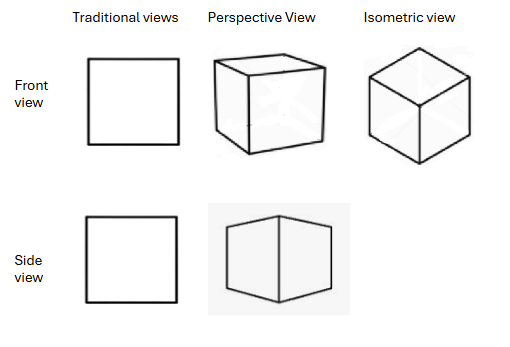
In this example, all views show the same design but the different angles give the impression of visual differences. The representations are acceptable because it is clear that the impression of difference is only created by the angles.
Cross-sectional views
Cross-sectional or sectional views show a hidden part of a product (internal features or other parts that a normal view would not adequately show) by cutting away or removing some of that product. The otherwise hidden parts should be indicated, for example by oblique hatching.
Cross-sectional views must be labelled accordingly and/or contain enough information to satisfy the examiner that the view is part of the product and not a separate product. The location of the cross-section should be readily understood and obvious from the representations. This may be indicated through arrows and letters, provided they do not cause uncertainty about the design (Designs (Formal Requirements for Designs Documents) Instrument 2022 Part 2, 7(11).
Applications containing cross-sectional views must also include at least one representation that shows the design in full.
Example of a section view properly labelled (Design 201510788)
Product name: A cooking vessel
Representations:
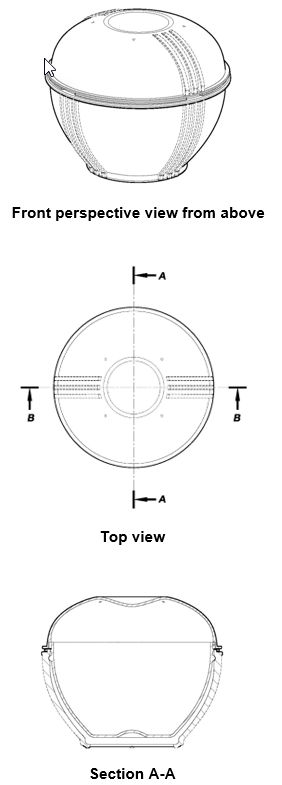
Exploded views
Exploded views show the individual parts of a product (e.g. a bottle and its cap) separately to indicate how they fit together.
Applications including exploded views must also include at least one representation that shows the design in its fully assembled state (e.g. a bottle with the cap on).
Exploded views will generally require labelling to satisfy the examiner that the view is part of the product and is not a separate product.
The following example (Design 201410741) shows an ‘exploded’ view appropriately labelled. The representations show a fully assembled view in the front view and then the exploded view.
Product name: Bottle
Representations:

More examples:
Product name: An eggcup with lid (Design 200513647)
Representations:
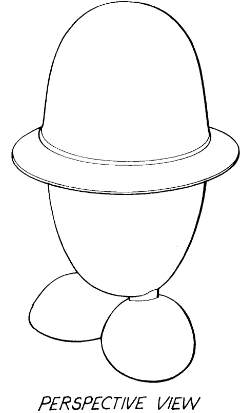
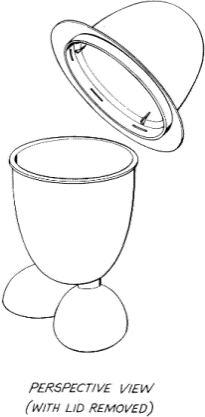
This is acceptable because the exploded view is labelled clearly enough (even without using the word ‘exploded’) and the other view shows the whole design.
(Design 201710462)
Product name: Drinking vessel
Representations:

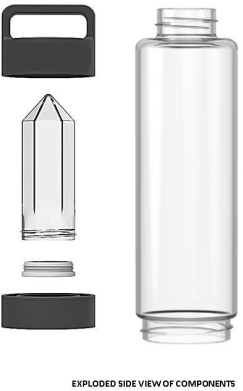
This is acceptable because the exploded view is labelled clearly, and the other view shows the whole design.
Configuration changes
Representations that show a product in various configurations may be acceptable if the design can achieve the configuration change in normal use. The representations showing these different configurations will generally need to be labelled to satisfy the examiner that they are showing different configurations of a design and that there are not further designs that should be separately applied for.
There also needs to be at least one representation that shows the entire design – e.g. the phone with the receiver on the cradle.
Example of an acceptable set of representations showing different configurations:
Product name: Laptop computer
Representations:

Representations showing complex products in various fully assembled forms do not demonstrate different configurations of a single design achievable through normal use. Instead, each fully assembled form is treated as a distinct design with different visual features and must be applied for separately.
Example of an unacceptable set of representations showing a complex product fully assembled in different arrangements. Even when labelled, these representations do not show a single product with a single design.
Product name: Interlocking drawers
Representations

Close-ups
Close-up views may be used to highlight the details or specific parts of a product. These views are the exception to the general requirement that all representations must be shown at the same scale or proportion. Close-up views of a product are allowable, so long as:
there is also a representation showing the design in full
they are otherwise consistent with the other drawings
it is readily understood that the representation is showing a close-up view and the specific part of the product the close-up view is highlighting must be obvious
Labelling will generally be required to satisfy the examiner that the view is part of the product and not a separate product.
Example of a representation that is unacceptable because it does not contain labelling and, if it is the sole representation, because it does not show the whole product:
Product name: Replaceable electric toothbrush head
Representations:
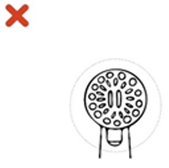
Example of an acceptable set of representations with a close-up view properly labelled and a view of the whole product:
Product name: Replaceable electric toothbrush head
Representations:
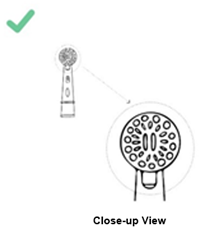
Example of representations where the close-ups are acceptable despite not using the word ‘close-up’.
Product name: Record player
Representations:

Amended Reasons
| Amended Reason | Date Amended |
|---|---|
update broken link |
|
Updated to include information about labelling and include some fresh examples. |
|
Formal Requirements Instrument |
